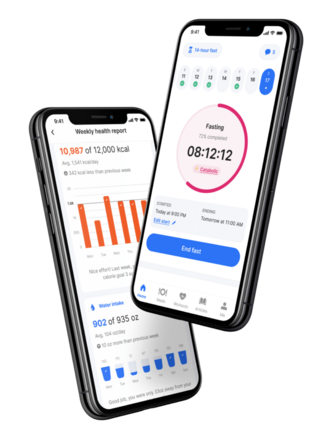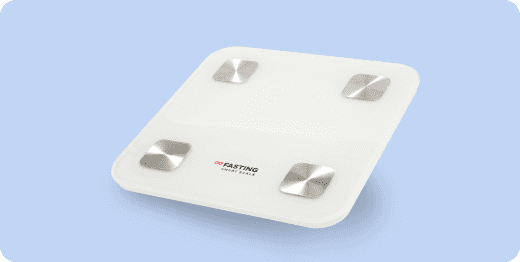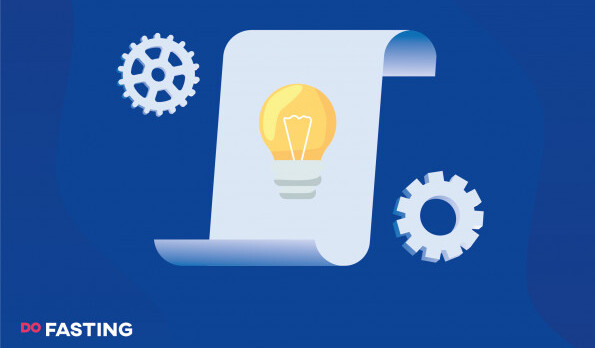Contents
What Is a 24-Hour Fast?
A 24-hour fast is done by abstaining from food for 24 hours. This is a rather similar schedule to OMAD (one meal a day), where you abstain from food for 23 hours and eat within a single hour.
The big difference is that OMAD is a rather strict continuous schedule, whereas the 24-hour fast can be done once a month, for example.
If you would have your meal at 6 p.m., you would have to abstain from eating until after 6 p.m. of the next day.
This is one of the more extreme intermittent fasting methods, due to the amount of time you need to abstain.
Among other types of time-restricted fasting periods, there are more beginner-friendly plans such as 14:10 IF and 16:8 IF.
Instead of losing weight over a shorter fasting period, the day-long fast targets body weight and body fat extremely efficiently. With this method, your body burns more fat cells, leading to longer windows of ketosis, autophagy, and insulin reduction, three of the most important stages of fasting.
This leads to kickstarting your digestive system and starts burning fat faster than ever, which is why it’s such a popular diet for people looking for a change faster than compared to other more traditional diets.
Take a
1-minute quiz
and discover how much weight you can lose with DoFasting!

What Happens if You Don’t Eat for a Day?
Many people have a similar concern around this type of fasting – is a 24-hour fast healthy? If you do it with supervision and follow a set plan, then the answer is yes.
The trick lies in lowering your overall calorie intake enough to start the 5 stages of fasting mentioned previously. In general, lost calories lead to weight loss.
But fasting is not just about calorie restriction or learning to live with hunger. Instead, it’s a scientific method used to push your body out of its comfort zone and get it to stop burning glucose for energy expenditure.
The body’s transition from consuming sugars to stored fats happens when calorie restriction activates ketosis, where you begin to lose fat about 16 to 18 hours into your fast.
After this, the body begins to repair itself through autophagy, release growth hormones, lower insulin levels, and rejuvenate the immune system and muscle tissue.
So, as you can see, there are quite a few advantages to fasting for a long period of time, as it gives your system a chance to virtually reset itself and start processes that help to achieve long-term health.
What Are 24-Hour Fast Benefits?
We already mentioned that a 24-hour fast has more benefits than meets the eye. Let’s take a closer look at what we can expect from this intermittent fasting type.
Helps to Promote Weight Loss
Typically the go-to result that people want out of hardcore fasting, is to lose weight which can be done quite effectively with this method.
Because this fast pushes your body into a metabolic process that results in fat loss, you will start to see pounds melting away without losing muscle mass.
This is thanks to metabolic ketosis, something that only starts about 16 hours into a fast, and gets more effective the longer you stay fasting for even more weight loss.
Increases the Production of Growth Hormones
Growth hormones are responsible for our continued development, sustained muscle mass, and overall aging in a natural way.
And because there is an increased release of growth hormones after reaching ketosis in prolonged fasting periods, this is a great way to keep your body healthy and encourage muscle retention, as well as weight loss.
Prolongs Life
In general, fasting is proven to have a myriad of benefits for your health, both in terms of body and mind, and can delay aging. You can also avoid some of the more common problems that come with aging, such as rheumatoid arthritis.
And because of this, you are likely to find yourself living longer, with an overall improvement in quality of life if you implement intermittent fasting into your schedule regularly and improve your gut health.
Aids in Cancer Prevention
Inflammation within the body is the culprit for a wide variety of health issues, and as such, if you introduce a way to reduce chronic inflammation before it even starts, you can reap many health benefits.
One of these may include cancer prevention, where it’s found that intermittent fasting has anticarcinogenic properties.
Helps Improve Brain Functions
Neurological functions are improved by fasting, as medical studies on animals have discovered – including cognitive decline due to aging.
This is a fascinating revelation, where sharpening the mind through treating the metabolic state is effective for memory issues and other related problems.
Helps Reduce the Risk of Developing Diabetes
By improving blood sugar control and blood sugar levels through burning fat stores instead of glucose, your risk of diabetes is lowered by fasting routinely.
Additionally, you can lower levels of blood triglycerides by either long or short-term intermittent fasting, helping to lower cholesterol in your body that might cause diabetic issues later on.
Reduces the Chances of Getting Various Cardiovascular Conditions
Fasting can help your metabolic rate to be more efficient, and lower your heart rate, blood pressure levels, and total cholesterol levels, making your chances of developing cardiovascular issues significantly lower as your heart health improves.
How to Fast for a Day?
In its essence, fasting is all about planning ahead and preparing yourself for success If you anticipate a day-long fast once a week, or more, then you need to set yourself up in advance.
Scheduling your fast is one of the best ways to ensure you are ready to go. To get started, figure out what meal you want to eat before starting the 24-hour fasting period.
For instance, if you want to fast from dinner to dinner, start the calorie restriction window after your last meal and continue on until it’s suppertime the next day. That could take the form of eating a healthy dinner at 6 p.m. on Wednesday, and then fasting until 6 p.m. on Thursday.
Alternatively, if breakfast is more important for you to eat, starting your fast right after you finish breakfast at 8:30 a.m. on Monday will last until breakfast the next day.
Discovering your fasting window depends on the tasks you need to complete, your lifestyle, comfort levels, and personal preference. Don’t be afraid to change it up every now and then, either.
As for frequency, whole-day fasting should only be done around twice a week. This will still give your body time to recover from the calorie deficit and give kickstarts the beneficial processes.
Additionally, always make sure to drink water or other zero-calorie beverages throughout the fast to keep yourself hydrated and comfortable.
How to Fast for a Day With The DoFasting App
One of the best tools to keep on track with your fast is a dedicated intermittent fasting app, complete with trackers, timers, and tips, as well as recipes and exercise routines.
By downloading the DoFasting app, you take the hassle out of monitoring your progress and having to remember when you started fasting, so you can focus primarily on your health and weight loss journey instead.
Take a
1-minute quiz
and discover how much weight you can lose with DoFasting!

What to Eat After a 24-Hour Fast?
Once you make it through your day-long fasting window, congratulations! The hard part is over. But the aftercare that comes with extensive fasting is just as important, so let’s dive right into what you should do afterward.
It might be tempting to have a large meal as soon as the fasting time is over, but do resist that urge.
Your digestive system has just gone through the phases of fasting and is still energized from that – the last thing you want to do is heap a ton of new foods into your belly and slow everything down again.
Foods to Eat After 24 Hours Fast
Eat foods that are easily digestible right after your fast, or a small meal with cooked foods that are also high in nutrients. Things like soups and smoothies are great options for initially breaking your fast, and don’t forget to drink water.
Here are some food options for what to eat after a 24-hour fast:
- Fermented Foods – Look for kefir and yogurt without sweeteners to ease back into eating.
- Healthy Fats – These include avocado, eggs, nuts, and fatty fish, and are excellent options for sating your hunger.
- Protein – Cooked protein is ideal for coming out of a fast, including chicken, beef, fish, and seafood.
- Vegetables – Cruciferous types of vegetables are perfect after a long fast, including broccoli and Brussel sprouts.
- Whole Grains – Opt for fibrous grains like spelt or kamut that are also high in protein after you finish fasting.
What about pre-planned meals to break your fast? These are some ideal dishes for you:
- Breakfast – Try chia seed and banana toast, a quick quiche, or baked sweet potato to break your fast with breakfast recipes!
- Lunch – Treat yourself to a healthy return to eating, and whip up some oven-baked Camembert with salmon salad for lunch.
- Dinner – Scrumptious main courses abound, including Cajun red beans and rice, or a chili beef avocado burger for the carnivores out there!
And if you want even more information on what you can eat after breaking a fast, check out the DoFasting app and its tremendous amount of recipes and meal inspiration.
Currently, there are over 5000 recipes that can be filtered according to your dietary preferences and needs. That includes options for vegans, paleo, gluten-free, low-carb, and many, many more, all situated in the “Meals” tab of the app.
Foods to Avoid after a Day-Long Fast
It’s important to give your body time to recover from the fast, so avoiding large meals and new foods is key. Other things you should not consume directly after the fast include:
- Alcohol
- Candy
- Dairy products
- Fast or processed foods
- Fruit juice
- Pressed meat
- Red meat
- Refined grains
- Soda pop
- Sugary foods
24-Hour Fast Weight Loss Results
Now, you might be wondering, after all of this – how many calories do you burn fasting for an entire day?
If you want to lose weight, this might be the most attractive intermittent fasting method in terms of results, so let’s focus on the weight loss outcomes of intermittent fasting for a moment.
Our users have experienced some great results by following intermittent fasting regimens, including the whole-day method. But the total of calories burnt and weight lost has a different impact for everyone based on how a body reacts to the deficit.
Weight loss can also be supplemented with a good exercise routine, that pushes the body even further toward more weight loss.
That being said, you can use a handy calculation called the BMR Formula to figure out how many calories your body burns, and adjust your likely results from there.
And if you want to be inspired by others who have tried this fasting method and had successful results, check out this testimonial by Sandra, who, after starting intermittent fasting, experienced major changes in her appearance and well-being.
Side Effects of Fasting for 24 Hours
There are several downsides that you can experience if you try fasting for a whole day-long period. And this should come as no surprise, after all, you are not feeding your body anything for a full day!
Let’s talk about some of the unpleasant side effects you might experience after a 24-hour fast. And if you have any pre-existing health conditions, you should always consult your doctor first.
Because you are going for so long without giving your body more nutrients to work with, you might end up feeling very tired or fatigued during the fasting period.
This might even transition into feeling irritable or cranky, but these side effects will generally wear off as you fast more frequently and your body becomes accustomed to it.
Headaches are another common side effect of intermittent fasting, which could be caused by low blood sugar, caffeine withdrawal, or dehydration. These can best be treated by drinking fluids and resting when it gets too much to bear.
Additionally, if you struggle with a consistent sleeping pattern, embarking on a 24-hour fast might have some side effects when it’s time for bed. For some people, the hunger felt during the fast can disrupt their circadian rhythm, leading to having a harder time falling asleep.
Who Should Avoid Doing Intermittent Fasting?
Unfortunately, intermittent fasting is not recommended for everyone, and certainly not a more intensive method like 24-hour fasting.
If you have pre-existing health conditions, or anything on the following list applies to you, consult with a doctor and get medical supervision before undertaking this type of diet:
- A history of eating disorders
- Cardiovascular diseases
- Chronic conditions
- Diabetes
- Heart disease
- Pregnant or breastfeeding
- Severe blood pressure issues
- Taking medication
Take a
1-minute quiz
and discover how much weight you can lose with DoFasting!

Conclusion
Now that we have explored the intricacies of completing a fast for 24 hours, the health benefits that come with it, and the ability to lose weight fairly quickly, we hope you are ready to change your life around.
Fasting for 24 hours is a surprisingly easy task to accomplish once you prepare in advance, and with the DoFasting app, it’s made even simpler. Time your fasts, plan your meals, and track weight loss progress all in the same place.
See how DoFasting will improve your life
Find out what works for you with this 60-sec quiz approved by our experts and get your personal revolutionary fasting assistant.
Start the Quiz














